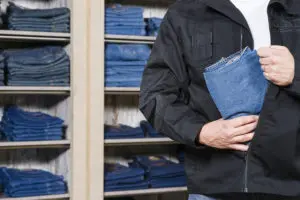Shoplifting causes shrink for companies that is difficult to contend with financially. According to the National Retail Security Survey, U.S. retailers reported $112.1 billion in losses in 2022.
On The Page
Businesses are increasingly using shoplifting prevention technology to boost profits. Some of these new shoplifting prevention technologies use computers, software and machines to detect theft. Not all technology designed to prevent theft is free from errors, which could result in unfair shoplifting charges.
Facial Recognition Software

Facial recognition software could connect an innocent customer with someone who has shoplifted in the past. The software is designed to recognize shoplifters from an extensive database by connecting the detected facial characteristics to photos stored in the database. This type of theft prevention technology could fail to identify the correct person if the individual is wearing accessories, such as glasses or a hat that could obscure or misidentify a person.
Facial recognition technology used by the FBI has wrongly convicted and incarcerated individuals for all types of crimes due to subjective estimates based on multiple corresponding characteristics identified by the software. Shape of the head, the jaw line, moles and ear characteristics are identified by facial recognition technology used for shoplifting prevention. Someone could be confused with a shoplifter simply because their major facial features match.
RFID Technology
Radio frequency identification (RFID) technology involves installing chips into valuable products so items can be tracked before leaving the store, therefore preventing the product from traveling far without being paid for. RFID could result in unfair theft charges because store associates could forget to remove the chips during checkout and the paying customer could be accused of stealing merchandise.
Video Analytic Software
Video analytic software is used by businesses to detect suspicious activity, such as hiding merchandise, leaving without paying for products, or dishonest cashiers. Footage obtained from store security cameras is evaluated by the software to instantly detect suspicious activity, but no program is fallible. What the video analytic software identifies as product concealment could simply be a shopper reaching into a purse or bag to obtain a personal item.
Smart Display Technology
Companies are also using theft prevention technology that utilizes technological devices installed on store merchandise or amenities, such as with smart display technology or anti-push out systems.
Smart display technology flags valuable or commonly stolen products to instantly alert loss prevention employees, sometimes with an alarm. Customer amenities such as shopping carts can be manipulated with an anti-push out system, which operates with underground wires inside and surrounding the store that prevent carts from leaving by triggering a lock on the wheels.
Mobile POS Systems
Mobile point of sale systems allows employees to check out customers on the sales floor. With mobile point of sale systems, employees can more closely monitor customers for suspicious activity. It is beneficial for the company to have a heightened surveillance by using mobile point of sale systems, but this theft prevention technology could possibly lead to inaccurate theft charges from overzealous employees.
AI-Powered Surveillance
While traditional video surveillance systems have been a staple in retail security, the integration of artificial intelligence (AI) has advanced the way stores try to detect and prevent shoplifting.
- Advanced video analytics: Beyond simple motion detection, AI can analyze shopper behavior in real-time, identifying suspicious patterns like loitering near high-value items, concealing merchandise, or working in tandem with other individuals.
- Real-time alerts: AI-powered systems can instantly alert security personnel to potential theft situations, allowing for rapid response.
- Predictive analytics: By analyzing historical data, AI can identify theft hotspots within a store and predict when and where theft is most likely to occur. This enables retailers to allocate security resources more effectively.
It’s crucial to note that AI systems are not perfect and can misinterpret innocent actions as suspicious behavior, leading to wrongful accusations and potential legal troubles.
Sensor-Based Systems
Sensor-based systems offer a more discreet approach to shoplifting prevention while providing real-time data on product movement.
- Shelf sensors: These tiny sensors attached to products can detect when items are removed from shelves without being scanned at the checkout.
- Weight-based sensors: Embedded in shopping carts or bags, these sensors can detect if additional items are placed inside without being paid for.
- Smart fitting rooms: Sensor-equipped fitting rooms can monitor the number of items taken inside and alert staff if the number exceeds what is typically allowed.
While these systems offer valuable data, they are not foolproof. Sensors can malfunction, leading to false alarms and accusations of theft when you’ve done nothing wrong.
Theft Prevention at Checkout
Employee theft makes up a large portion of retail loss, and theft at the checkout counter is one of the prevailing problems among stores. This often occurs when a cashier is checking out a friend or family member and fails to scan items.
A Massachusetts startup company called StopLift tries to solve this problem for retailers with a service that combines overhead cameras and artificial intelligence that detects when products aren’t scanned at the checkout counter.
As an increasing number of retailers add self-checkout as an option, this type of technology could be key for retailers to prevent shoppers from sneaking items into their bags without scanning them. However, the technology is still relatively new and, as with other technologies, has a lot of room for possible error.
Answers to Frequent Asked Questions About Shoplifting
Can You Be Arrested for Shoplifting Even if You Don’t Leave the Store?
In Texas, a retailer may claim that an item was intended to be stolen if the item was hidden in a backpack or was concealed in a way that made it obvious that it was hidden.
Employees and security guards often wait for a suspected shoplifter to leave the store before approaching them since it is easier to prove theft when the suspect is gone. But it is not necessary for the person to leave for their intent to shoplift to be proven.
What Should I Do If I Am Accused of Shoplifting?
• Remain calm, and ideally, stay silent.
• Keep in mind that the store owner or security guard only have the right to detain you if they have probable cause that you have stolen something, but they do not have any right to use excessive force.
• Call an experienced shoplifting attorney.
• Cooperate politely and wait for your attorney to arrive.
Is it Possible to Clear a Shoplifting Charge From Your Record is Houston?
There are two ways to clear a shoplifting charge from your record in Houston. An experienced shoplifting attorney can help you decide on the best option for your case.
• Deferred Adjudication requires that you enter a guilty plea to the shoplifting charge and in return, you are placed on probation for six months to a year. This process will seal your records to everyone but the government and law enforcement.
• Pretrial Diversion is the only way to have your case completely dismissed. You can apply for this with the DA, and if they accept, you will work many extra community service hours and enter an agreement for a zero-tolerance policy for breaking the law.
Accused, Charged or Arrested for Theft
Not every theft charge results in conviction. To avoid fines and incarceration for shoplifting, you need an aggressive defense from an experienced Houston shoplifting lawyer and former prosecutor. Lisa Shapiro Strauss has nearly 20 years of experience and can help you fight shoplifting charges. For a free consultation, call 713-449-9922.




